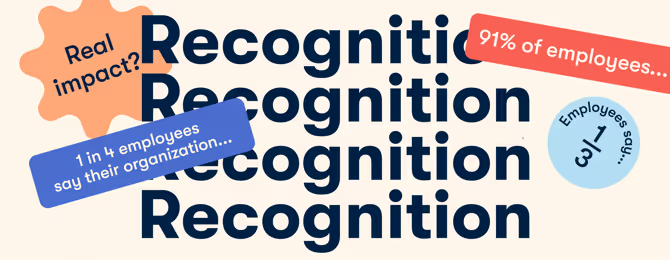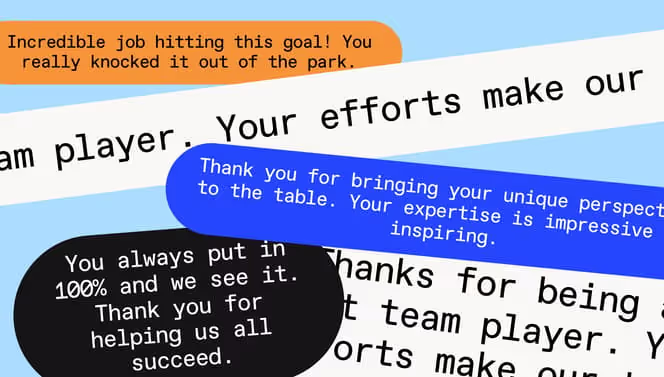Employee recognition stats to blow your mind (based on 50,000+ teams surveyed)

Discover Workleap Officevibe's benchmark report on 12 key employee engagement metrics

Every human being wants to feel seen and valued — especially at work. Employees want to know their efforts don’t go unnoticed and that their contributions have value. That's why employee recognition is such an important part of management.
There’s a lot to learn from current employee recognition trends and statistics. How much does appreciation count for employees? Do recognition efforts impact other aspects of work and performance? And are managers getting it right?
We gathered insights from Pulse Survey data across 50,000 teams worldwide to reveal some of the most comprehensive employee performance and engagement statistics relating to recognition.
Get ready for your mind to get blown — scroll to find out more.
TL;DR: Employee recognition statistics cheat sheet
- 37% of employees say they don't receive recognition frequently enough.
- 1 in 3 employees feel recognition isn’t given in a timely fashion.
- 87% of employees say recognition is meaningful when they receive it.
- 74% of employees pay attention to praise given at an organization level.
- 1 in 4 employees feel their organization doesn't celebrate accomplishments and learnings.
- 89% of employees say they're encouraged to give recognition to one another.{emphasize}
Starting with the basics: What is employee recognition?
Before diving into statistics, let’s first align on the basics. Employee recognition is, simply, acknowledging the efforts or achievements of employees.
Employee recognition takes many forms — verbal, written, and even tangible rewards. The aim is essentially to reinforce positive behaviors, boost morale, and foster a culture of appreciation in the workplace.
As a big part of performance management and feedback strategies, employee recognition is led by managers. That said, everyone can and should participate in recognition efforts.
It’s a new world: Modern trends in employee recognition
Some things remain the same, no matter the era. The concept of pats on the back for a job well done, for example, probably hasn’t changed much from decades ago to now. Verbal praise also remains popular. Everybody still likes to hear “Good job!” once in a while. That said, some traditional methods of employee recognition are definitely evolving.
With company structures moving away from silo mentality, there’s a growing emphasis on peer-to-peer recognition. And, with new remote work environments taking over the professional world, digital platforms that facilitate real-time feedback are gaining traction. The next generation of workers also demand for more personalization in their work experiences, and they value recognition that feels genuine and tailored to their contributions.
Context matters: Industry-specific recognition trends
Employee recognition trends can also be industry-specific. After all, different industries have unique cultures and dynamics that can influence how recognition is practiced or perceived. For example, tech companies often prioritize peer recognition and innovation rewards, whereas the healthcare industry focuses on patient outcomes and team achievements.
What type of recognition do employees value the most?
There are many different types of employee recognition and ways to deliver this. Ultimately, employees value recognition that’s timely, specific, and sincere.
Of course, who doesn’t love to receive a monetary reward? But even simple gestures like a heartfelt “thank you” or a public shoutout from a boss during a team meeting can have a profound impact — and those moments of recognition shouldn’t be overlooked.
Recognition channel preferences
While all employees need to feel acknowledged, not everyone has the same set of preferences. Some employees value the confidence boost of being praised in front of peers, while more shy employees might prefer private one-on-one praise.
Managers have to figure out which formula works best depending on the individual.
Also, the rise of remote and distributed teams has increased the reliance on technology — and this goes the same for relying on digital platforms for recognition. Employees appreciate tools that make recognition seamless and accessible — be it through email, chat apps, or dedicated platforms.
The key: A balanced recognition type distribution
Ultimately, a well-rounded employee recognition strategy incorporates all types of recognition, including:
- Verbal recognition: Expressing appreciation verbally in person or through video calls. It's personal, immediate, and can be tailored to the individual employee.
- Written communication: Can take various forms — emails, instant messaging, or handwritten notes. It can be saved for future reference and serve as a tangible reminder of appreciation.
- Public acknowledgment: Praising employees in front of their peers, like in team meetings or via company-wide emails. It celebrates achievements openly and encourages a culture of appreciation.
- Peer-to-peer recognition: Where colleagues acknowledge each other's contributions. This fosters a sense of camaraderie and teamwork.
- Managerial recognition: When recognition comes from managers. This holds significant weight and can be formal or informal, within performance reviews, one-on-one meetings, or special awards presented by leadership.
- Digital platforms: Have become increasingly popular with the rise of remote work, allowing for real-time feedback, virtual badges, and interactive features.
Reward programs: Tangible rewards like gift cards, bonuses, or extra time off. These incentives can be motivating, but they aren’t given as often as other forms of praise.
By balancing these different types of recognition — and applying a mix of verbal, written, and tangible tokens of recognition — managers ensure their teams feel valued and appreciated in a way that works for them.
Why is employee recognition so important?
Providing employee recognition can have a huge impact on employees and companies overall — influencing engagement, productivity, and loyalty. Appreciation isn’t just a nice-to-have — it ultimately impacts the organizational bottom line.
SHRM’s latest study on employee experience outlines appreciation as one of the four most critical aspects of work, according to HR professionals and workers.
{emphasize}
Impact on employee morale
Recognition helps love the work. Recognized employees feel more valued and appreciated, which leads to higher job satisfaction and morale.
{emphasize}
{emphasize}
Influence on employee engagement
Recognition makes work meaningful. Recognition is closely linked to employee engagement, and engaged employees contribute to overall organizational success.{emphasize}
{emphasize}
Relationship between recognition and productivity
Recognition motivates and incentivizes. Acknowledged employees are more likely to go above and beyond — leading to increased productivity and performance.{emphasize}
{emphasize}
Connection to employee performance
Recognition reinforces good behaviors. By highlighting exemplary performance, managers inspire others to strive for excellence and continuous improvement.{emphasize}
{emphasize}
Impact on team collaboration
Recognition bonds teams. By showing support and celebrating collective successes, stronger relationships lead to smoother collaboration (and better outcomes).{emphasize}
{emphasize}
Recognition and retention rates
Recognition lowers turnover. It makes sense: employees who feel valued and appreciated are more likely to stay with their organization in the long run.{emphasize}
Recognition ROI: Mind-blowing employee recognition statistics — based on data across 50,000 teams worldwide
Employee recognition isn’t something to sleep on — and this claim is based on hard evidence. We pooled survey data from over 50,000 teams worldwide to provide you with some hard-to-ignore employee recognition statistics:
Recognition frequency statistics
37% of employees say they don't receive recognition frequently enough.
When it comes to recognizing employees, the main area for improvement is frequency. Employees want recognition more often — but how often is enough? While “too much praise” is almost impossible, managers can ask what their employees would prefer via a Pulse Survey.
{emphasize}Recognition frequency is the second lowest scoring sub-metric out of the 26 sub-metrics of employee engagement.
This tells us that recognition frequency is one of the most underserved engagement tools. When managers wait until quarterly reviews or monthly meetings to praise employees, this simply doesn’t hit the mark that employees expect.
While it can be tough to create regular recognition rituals (especially when working remotely), setting yourself daily or weekly reminders to send out a couple of kudos to your team should help you build up a habit of giving recognition.{emphasize}
1 in 3 employees feel recognition isn’t given in a timely fashion.
Beyond recognition frequency, it's important to provide praise in real-time, too. When employees receive acknowledgment months after the fact, its value is diminished. Momentum is everything. In fact, why wait? Recognition can also mean a lot when work is still in progress.
{emphasize}Timeliness in action: Tricks to jump on recognition opportunities right away!
If managers notice someone on their team doing good work or acting in alignment with the company values, they should send a quick employee recognition message via Slack or email. There’s no time like now, and you should seize every opportunity to praise in case the next recognition window is too late.{emphasize}
All in all, don't wait until your team sees the results of their latest initiative to celebrate their success. In fact, don't even wait for them to deliver their work — provide praise as things move along to keep motivation levels high. But remember, moments of recognition should be regular. In between achievements, praise can simply be about a good attitude or collaboration, which is part of every day. Managers should let each employee know that their individual efforts are seen and valued often and in real time.
Recognition quality statistics
87% of employees say recognition is meaningful when they receive it.
This goes to show that most recognition efforts are valued — regardless if it’s about something important or a less significant effort. Praise is appreciated, no matter what it’s about. Put simply, it's better to say 'thank you' than nothing at all.
{emphasize}'Is recognition meaningful when you receive it?' is in the top 10 highest-scoring questions across Officevibe surveys.
What does this tell us? That employees take notice of recognition efforts, regardless of what it’s about. While it's natural to want to be intentional and come up with amazingly creative and unique ways to show your team recognition — employees don't need elaborate displays to feel appreciated. It's truly the thought that counts.{emphasize}
74% of employees feel adequately recognized at an organizational level.
Recognition from direct supervisors and managers counts for a lot — but it’s important to remember that appreciation is also a culture-building tactic and helps everyone feel part of the bigger picture. Employees pay attention to recognition efforts from an organizational standpoint too.
{emphasize}Making appreciation a company matter.
It’s possible to shout praise from the rooftops without making a scene. Recognition programs that take the form of an Employee of The Month section within an internal newsletter or Slack channel are a great way to provide public shoutouts at a company level.{emphasize}
Managerial recognition statistics
1 in 4 employees feel their organization doesn't celebrate accomplishments and learnings.
Company culture has a big influence on job satisfaction and the overall employee experience. An environment that celebrates wins and seeks out learnings (even when initiatives fail) will increase employee motivation and reduce the risk of burnout. Similarly, forgetting to celebrate accomplishments will create disengaged employees.
{emphasize}Looking to create more moments of celebration? Try this trick.
Create a 'win of the week' and 'fail of the week' awards — an exercise all team members can participate in. By encouraging everyone to share their accomplishments and what they could’ve done better, discussions are sparked and learning moments happen.{emphasize}
Peer-to-peer recognition statistics
89% of employees say they're encouraged to give recognition to one another.
This is great news as peer recognition has a big impact on employees. As valuable as recognition can be when it comes from direct managers or leadership, hearing you did a good job from someone whose day-to-day looks more like yours can mean a lot. Managers should continue to encourage their teams to build a culture of peer recognition together.
{emphasize}Making a culture of recognition come alive.
Like a spirit stick, a peer recognition activity could be for a trophy to get passed from one employee to another every month — with the winner designated by the team. It’s another way to get everyone involved in sharing praise and create a recognition program that invites everyone’s participation!{emphasize}
{emphasize}
Global recognition statistics — what’s happening around the world?
The Deloitte Greenhouse Experience Group surveyed over 16,000 professionals across 4,000 organizations around the world (from C-suite leaders to junior staff members) about their recognition preferences
While there are some strong general preferences across all professionals, such as new professional opportunities being preferred over salary bumps, there are some key differences too, based on demographic factors like generation or gender.
For example, Baby Boomers prefer private recognition compared to Millenials — whereas younger generations who grew up with social media, like Gen Z workers, are more accustomed to public praise.{emphasize}
How companies can effectively implement recognition programs in their management strategies
Understanding the power of data in shaping effective management strategies is key for any manager. Feeling inspired by the above employee recognition statistics? Here are the next steps we suggest to fine-tune your recognition programs and maximize their impact.
Leverage employee appreciation data
Use your own data collected from employee recognition moments to gain insights into which behaviors and achievements are being acknowledged most frequently. This might reveal what is being properly recognized — as well as what’s being overlooked.
Maybe your company gives great bonuses once a year, but forgets to proverbially high five successes day-to-day. Having access to this kind of information will help you tailor recognition efforts to align with what employees value most.
Get employee feedback on recognition
Keep inquiring with those whose opinion matters the most — employees! By soliciting feedback from employees on their experiences with recognition programs, they’ll be able to provide you with insights specific to your company realities. They might even inspire a few great ideas!
Ask them about the types of recognition they find most meaningful, as well as areas for improvement, and incorporate this feedback into the design and implementation of future recognition initiatives to ensure they resonate with your current workforce.
Measure recognition program effectiveness often
Last but not least — regularly evaluate the effectiveness of your recognition programs to ensure they continue to meet their intended goals. What works today might not work tomorrow, so adjusting recognition strategies at need is non-negotiable.
By keeping an eye on metrics such as employee engagement levels, retention rates, and performance indicators, you’ll be able to keep your finger on the pulse when it comes to recognition efforts.
Building a culture of recognition with Workleap
We gathered insights from Pulse Survey data across 50,000 teams worldwide to unveil some of the most impactful employee recognition statistics — which was no easy feat! But thanks to our wonderful partners, our collective insights are your gain.
From frequency of recognition to its impact on team morale, employee engagement, and productivity, these stats shed light on how much appreciation at work really does matter. It’s about connecting big and small moments to create a workplace where all employees feel valued and motivated to do their best work.With all that’s happening in the world, investing in employee recognition is more crucial than ever. The key here is to remember that moments appreciation isn’t a one-time event — it’s part of an ongoing commitment of continuous improvement.
{highlight}Find out how your employees feel about your current recognition program. Employee recognition is one of the 10 engagement metrics measured through Officevibe's Pulse Surveys. You can test it out by signing up free — you’ll be able to invite your team to answer five simple questions every week and start collecting insights on how employees really feel.{highlight}
Give HR and managers the clarity, confidence, and connection to lead better every day.


%20(1).avif)


.avif)
.avif)








